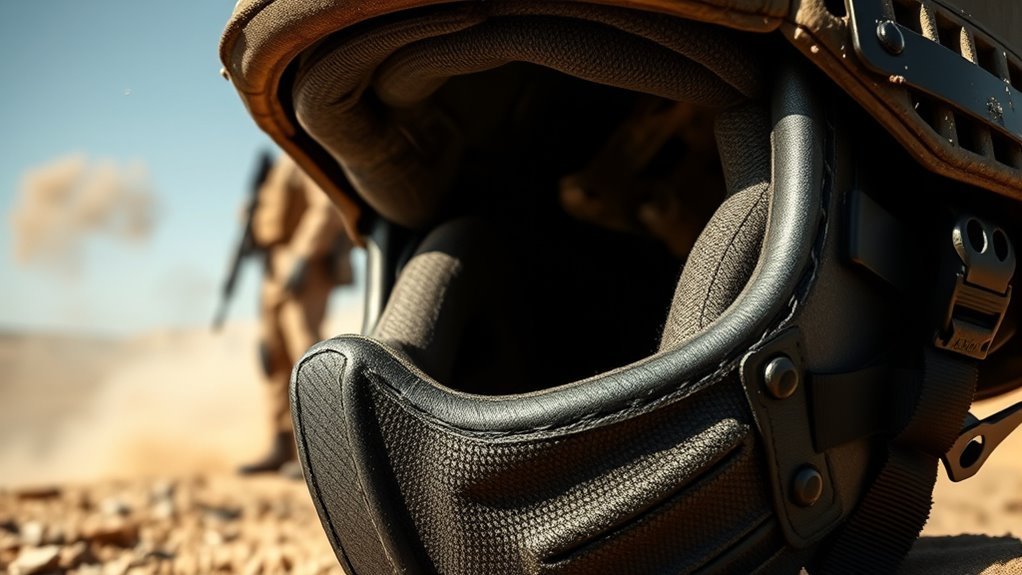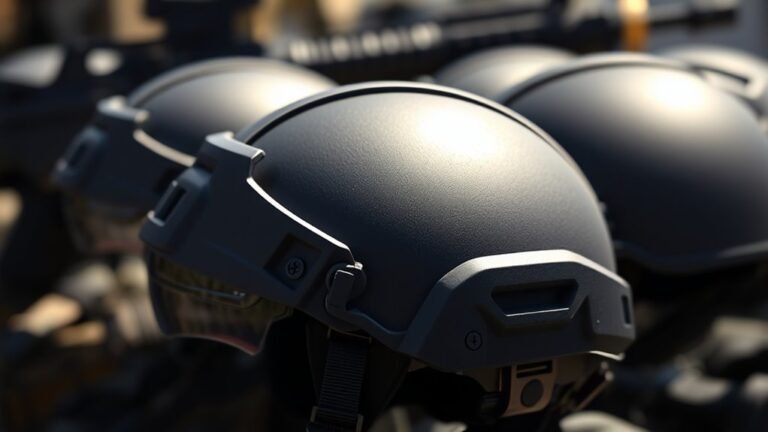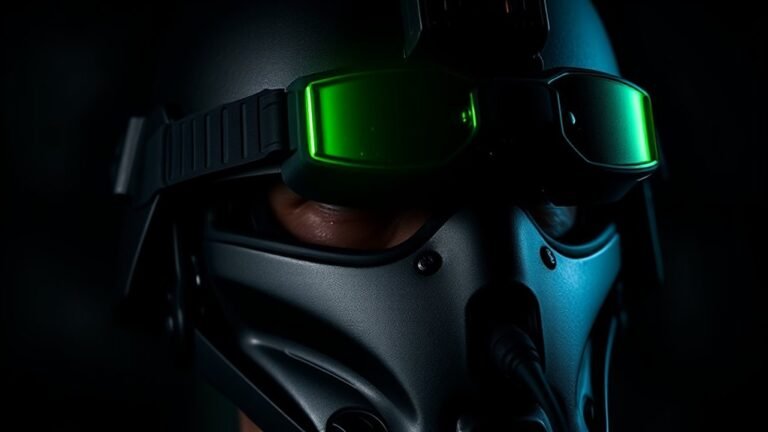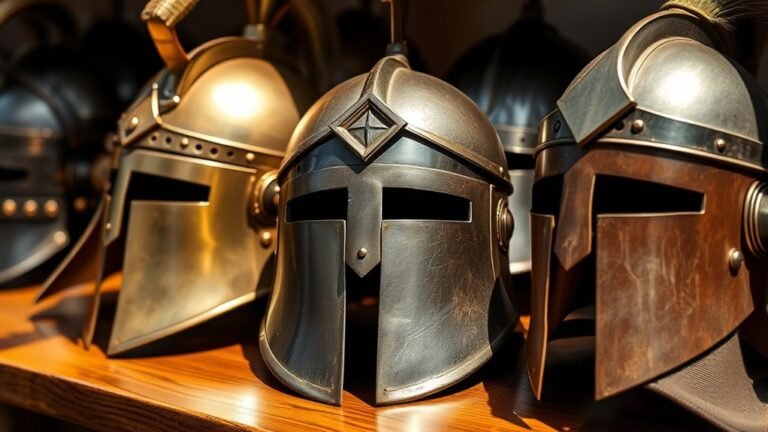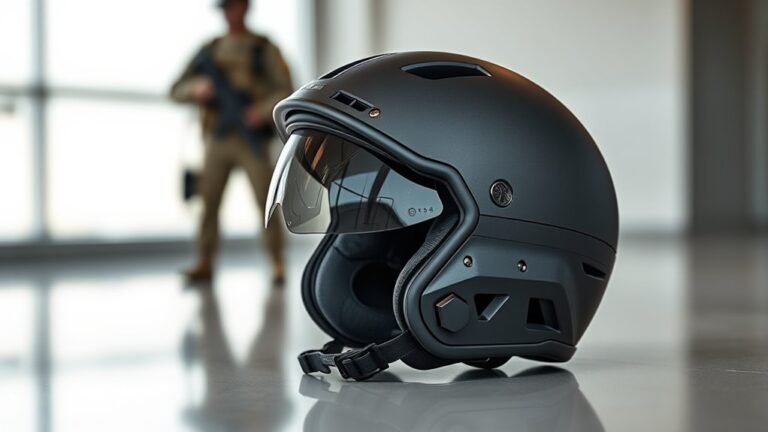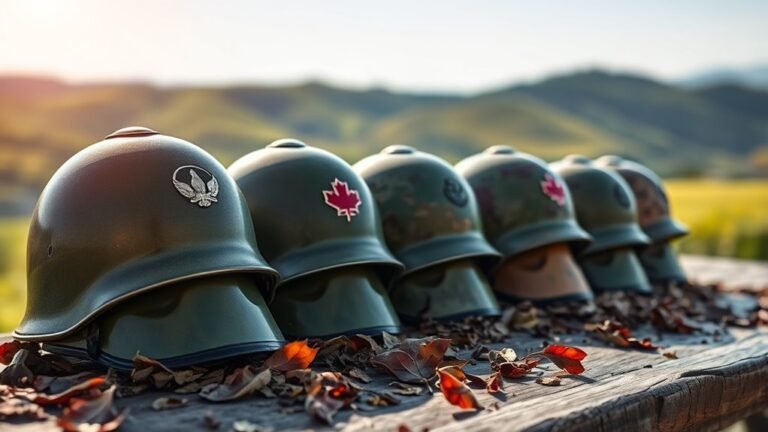How Kevlar Helmets Protect Soldiers
Kevlar helmets protect you by utilizing a unique composition of synthetic fibers that provide exceptional tensile strength and impact resistance. They’re engineered through a meticulous layering process, allowing them to absorb energy from high-velocity projectiles and explosive fragments. Proper fit and comfort enhance your operational effectiveness while advanced technology reduces weight without sacrificing protection. As you engage in combat, these helmets considerably lower the risk of head injuries, ensuring your safety and effectiveness on the battlefield. Learn about their real-world impact next.
The Composition of Kevlar: What Makes It Strong
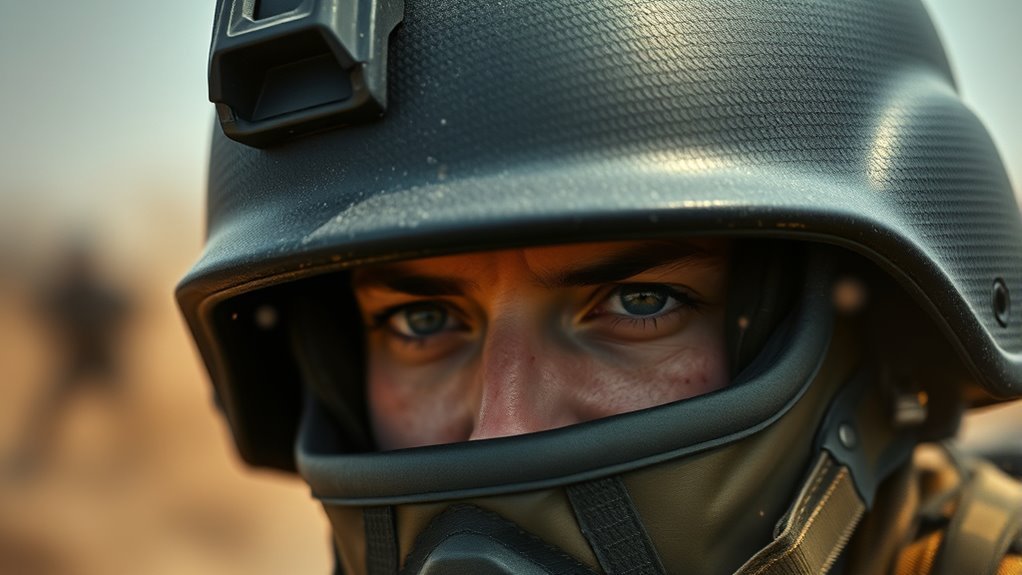
Kevlar, a synthetic fiber known for its impressive strength, is primarily composed of long molecular chains that create a highly resistant material. These Kevlar fibers exhibit exceptional tensile strength, which is the ability to withstand tension without breaking. The unique arrangement of the molecular chains results in a lightweight yet incredibly durable structure, making it ideal for protective gear. When you consider the demands placed on soldiers in the field, the high tensile strength of Kevlar becomes essential for safeguarding against ballistic threats. The interlocking nature of the fibers enhances energy absorption, further increasing its protective capabilities. Understanding this composition helps you appreciate how such a seemingly simple material can provide soldiers with the freedom to operate in high-risk environments while ensuring their safety.
The Manufacturing Process of Kevlar Helmets
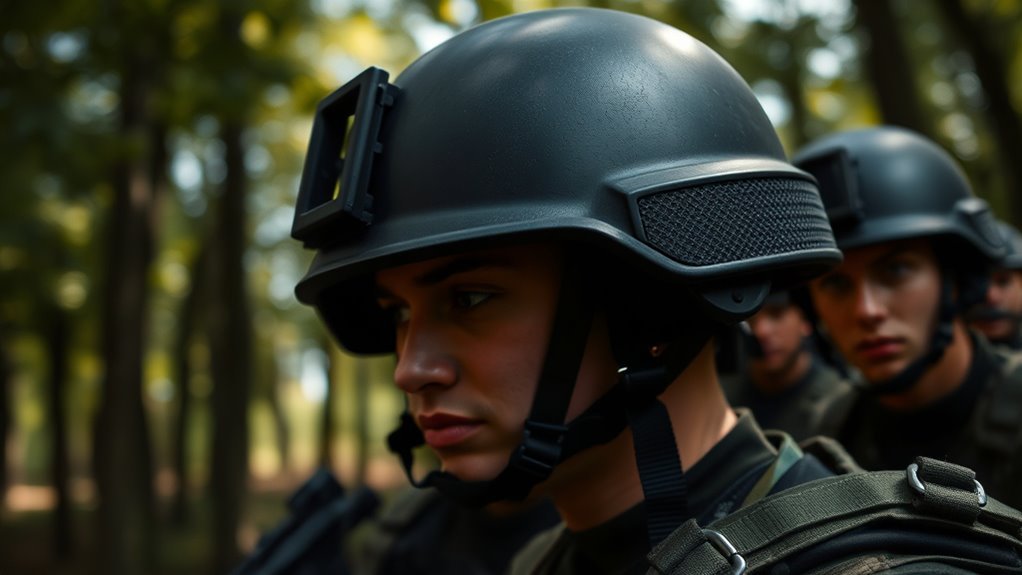
Although the manufacturing process of Kevlar helmets may seem straightforward, it involves several intricate steps to guarantee maximum protection and durability. First, advanced manufacturing techniques, such as layering Kevlar fibers and resin infusion, create a lightweight yet robust structure. Each layer is meticulously positioned to enhance ballistic resistance. Once the helmet is formed, it undergoes rigorous quality control measures to verify that it meets military standards. This includes testing for impact resistance and environmental durability. After passing these tests, the helmets are subjected to final inspections, focusing on surface imperfections or structural flaws. Ultimately, this thorough manufacturing process assures that you receive a helmet designed for peak performance in the field, safeguarding your freedom with every wear.
Types of Ballistic Threats Addressed by Kevlar Helmets
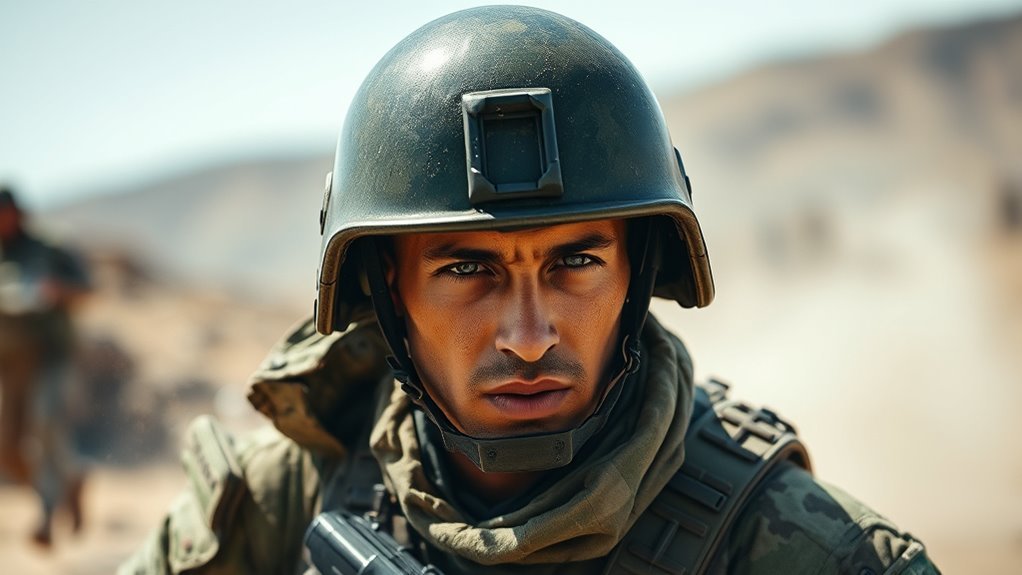
The advanced manufacturing techniques used in creating Kevlar helmets equip them to address various ballistic threats faced by soldiers in the field. These helmets are designed to withstand multiple ballistic types, including fragments from explosives, high-velocity projectiles, and shrapnel. When you wear a Kevlar helmet, you’re protected against common helmet threats like those posed by rifle rounds and other heavy-duty firearms. The layering of Kevlar fibers absorbs and disperses the energy from these impacts, minimizing penetration and reducing blunt force trauma. Additionally, advancements in helmet design enhance protection against specific threats while maintaining a lightweight profile. This balance of strength and weight is vital for soldiers needing mobility and protection in combat situations.
The Importance of Fit and Comfort in Helmet Design
When it comes to helmet design, achieving the right fit and comfort is essential for maximizing a soldier’s operational effectiveness. A helmet that’s too loose or tight can hinder performance and focus. To enhance usability, modern designs incorporate various elements:
- Fit adjustments: Allow for personal customization, guaranteeing stability during movement.
- Comfort materials: Utilize high-quality padding that minimizes pressure points and absorbs sweat.
- Weight distribution: Guarantees the helmet doesn’t tilt or shift, promoting balance.
- Ventilation features: Enhance airflow, preventing overheating during extended wear.
Advances in Kevlar Technology for Enhanced Protection
You’ll find that recent innovations in Kevlar technology focus on creating lighter materials without compromising strength. These advancements enhance impact resistance, allowing for better protection against a variety of threats. Additionally, improved durability features guarantee that helmets withstand harsh conditions, extending their operational lifespan.
Lightweight Material Innovations
As advancements in material science continue to evolve, innovations in Kevlar technology are playing an essential role in enhancing the protective capabilities of military helmets. The focus on lightweight design is vital, allowing soldiers to maintain agility without sacrificing protection. Key developments in this area include:
- Innovative composites that combine Kevlar with other advanced materials for improved strength.
- Enhanced weaving techniques that create a denser structure while reducing overall weight.
- Nanotechnology integration, which adds durability at a microscopic level.
- Thermal regulation features that keep soldiers comfortable in various environments.
These innovations not only improve the helmet’s protective qualities but also guarantee that soldiers can move freely and effectively, embodying the spirit of independence on the battlefield.
Improved Impact Resistance
Although traditional Kevlar offers substantial protection, recent advances in Kevlar technology have considerably improved impact resistance, ensuring enhanced safety for soldiers on the battlefield. These innovations focus on optimizing impact absorption, allowing the helmet to effectively absorb and dissipate energy from high-velocity projectiles or blunt force trauma. The latest Kevlar formulations incorporate advanced fibers and layering techniques that enhance energy dispersion across the helmet’s surface, minimizing the force transmitted to the wearer’s head. This enhanced capacity for impact resistance not only reduces the likelihood of injury but also bolsters the soldier’s confidence in their protective gear. As these technologies evolve, the potential for even greater safety and performance continues to expand, empowering soldiers with the freedom to operate effectively in combat environments.
Enhanced Durability Features
While advancements in Kevlar technology have markedly enhanced impact resistance, equally important are the improvements in durability features that guarantee helmets withstand harsh environmental conditions and prolonged use. Enhanced durability confirms that soldiers can rely on their gear under various circumstances.
Key features include:
- Advanced materials: New composites enhance resistance to abrasion and wear.
- Humidity resistance: Helmets are designed to repel moisture, preventing degradation.
- Temperature resilience: They maintain structural integrity in extreme heat and cold.
- Durability testing: Rigorous evaluations simulate real-world conditions to confirm long-lasting performance.
These advancements in environmental resistance not only extend the lifespan of Kevlar helmets but also support the freedom of movement and confidence that soldiers need in the field.
Real-World Impact: Case Studies of Kevlar Helmet Effectiveness
In analyzing combat situations, you’ll see how Kevlar helmets have greatly reduced head injuries among soldiers. Injury prevention statistics illustrate the effectiveness of these helmets in real-world scenarios, highlighting their life-saving potential. Additionally, survivor testimonials provide compelling evidence of the helmets’ impact on soldier safety during critical engagements.
Combat Situations Analysis
As combat scenarios evolve, the real-world effectiveness of Kevlar helmets becomes increasingly crucial for soldier safety. These helmets provide essential tactical advantages in various environments, proving their worth in high-stakes situations. Analyzing case studies reveals their impact:
- IED Protection: Kevlar helmets can mitigate blast effects from improvised explosive devices.
- Ballistic Defense: They offer substantial resistance against shrapnel and small arms fire.
- Weight Distribution: Modern designs enhance comfort, allowing for prolonged wear without fatigue.
- Communication Integration: Many helmets are now equipped for better communication, critical in coordinated operations.
Understanding these factors highlights how Kevlar helmets not only save lives but also improve operational effectiveness, ensuring soldiers can focus on their mission with greater confidence.
Injury Prevention Statistics
Kevlar helmets have demonstrated considerable effectiveness in preventing injuries during combat, with statistics highlighting their real-world impact. Studies indicate that injury rates among soldiers wearing Kevlar helmets have decreased by up to 45% compared to those using older helmet models. This reduction showcases the advanced materials and design that enhance soldier protection against ballistic threats and blunt force trauma. Furthermore, a thorough analysis of combat scenarios reveals that Kevlar helmets provide essential defense in high-risk environments, markedly lowering the incidence of head injuries. As a result, soldiers equipped with these helmets are more likely to return home safely, underscoring the importance of incorporating cutting-edge protective gear in military operations for ideal injury prevention.
Survivor Testimonials
Survivors of combat situations often credit their Kevlar helmets with saving their lives. These helmets are more than just protective gear; they embody the resilience and courage of soldiers. Survivor stories illustrate how these helmets endure extreme conditions, providing essential protection. Here are a few soldier experiences that highlight their effectiveness:
- Direct Impact Protection: Many report surviving shrapnel and bullet impacts thanks to the helmet’s advanced materials.
- Increased Confidence: Soldiers feel more secure, enabling them to focus on their missions.
- Enhanced Situational Awareness: The design allows for better hearing and visibility, vital in combat.
- Psychological Safety: Knowing they have reliable protection fosters mental resilience.
These testimonials not only emphasize the helmets’ physical benefits but also their profound impact on soldier morale and effectiveness.
Frequently Asked Questions
How Long Do Kevlar Helmets Typically Last in Service?
Kevlar helmets typically last around 5 to 10 years, but their lifespan can vary considerably based on service conditions. Imagine a helmet facing harsh environments, enduring extreme temperatures and impacts, versus one kept in controlled, stable settings. The former may degrade quicker, losing its protective qualities. Regular inspections are essential to guarantee your helmet remains effective, as wear and tear can compromise safety, putting you at risk during vital moments. Always prioritize your protection.
Can Kevlar Helmets Be Repaired After Damage?
Yes, Kevlar helmets can be repaired after damage, but the feasibility depends on the extent of the damage. You’ll need to conduct a thorough damage assessment to determine if repair techniques, like patching or reconditioning, are viable. Minor surface damage might be repairable, while deep structural compromises often require replacement. Always consult with certified professionals to guarantee the helmet maintains its protective capabilities and meets safety standards before using it again.
Are There Different Sizes for Kevlar Helmets?
Yes, there are different sizes for Kevlar helmets, much like a tailored suit that fits just right. Helmet sizing is vital, as a proper fit guarantees peak protection and comfort. Manufacturers provide fitting guidelines that detail how to measure your head accurately. You’ll typically find sizes ranging from small to extra-large, so it’s important to choose the right one for your unique head shape. A well-fitted helmet can make all the difference in critical situations.
How Do Kevlar Helmets Perform in Extreme Temperatures?
Kevlar helmets exhibit remarkable temperature resilience, maintaining structural integrity in extreme conditions. Their thermal insulation properties help shield you from both heat and cold, ensuring comfort during operations. In high temperatures, the helmet dissipates heat effectively, while in frigid environments, it minimizes heat loss. This balance is essential for operational effectiveness and wearer safety, allowing you to focus on your mission without worrying about helmet performance in harsh climates.
What Is the Weight of a Standard Kevlar Helmet?
You might be surprised to learn that a standard Kevlar helmet typically weighs around 3 pounds. When you consider helmet specifications, it’s important to recognize how this weight compares to other types of helmets. While some may prefer lighter options for mobility, Kevlar’s durability provides essential protection, making it a worthwhile trade-off. Ultimately, the balance between weight and safety is critical for ensuring freedom in the field.
